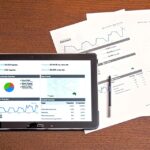
When was the final time you wrote a examine? On this digital age of banking, writing checks and balancing a checkbook might look like a factor of the previous.
You is perhaps stunned, however folks do nonetheless use checks for issues like paying payments and giving to charity. And figuring out learn how to steadiness a checkbook is a crucial side of maintaining monitor of your monetary well being.
It’s not simply the checks written you need to preserve monitor of. It’s additionally each debit and credit score transaction.
Though it may need been extra frequent on your grandparents, trying over your transactions and receipts is as related as we speak as in a long time previous.
What does balancing a checkbook even imply?
Balancing a checkbook is solely ensuring your whole checking account transactions match as much as the transactions you have recorded in your checkbook. Here is some background details about this.
The historical past
Earlier than on-line banking and being able to examine your account balances on cell telephones, having a checkbook register was key in ensuring one didn’t spend an excessive amount of and overdraft their checking accounts.
In spite of everything, check-writing was the way you accessed the cash in your account, and it might take days to ensure that that examine to clear.
Balancing a checkbook, often known as financial institution reconciliation, helped checkwriters not solely preserve monitor of the checks that had been written but in addition gave present details about how a lot cash that they had.
Balancing a checkbook as we speak
As we speak, balancing your checkbook or reconciling your checking account is used as a method to match your financial institution statements along with your file of transactions. It’s also very useful for monitoring transactions like ideas or service expenses.
As a result of all it takes is one error, and your receipt not matches what the debit quantity was.
So in easy phrases, balancing your checkbook helps you retain a operating checklist of credit and debits. It’s a method to monitor any cash in and cash out of your accounts.
You may also use your data to examine in opposition to the financial institution’s data of your transactions. Everyone knows that banks make errors too!
Do it’s essential steadiness a checkbook?
Cell banking apps and on-line entry make it simple to see transactions shortly. As we speak now we have nearly immediate entry to our banking transactions, and debit card buys clear nearly immediately.
Nonetheless, it’s vital to reconcile your receipts along with your financial institution info anyway.
It is helpful if you happen to write checks and to maintain a file of your cash
For some, we should still want to put in writing checks to companies or corporations that don’t settle for card transactions like paying your lease or small companies.
Maintain a file of your whole transactions in a checkbook register or perhaps a easy pocket book as a transaction log.
As well as, there are occasions when pending transactions can skew the obtainable steadiness in your checking account.
And since automated withdrawals and pending transactions can take days to clear, it is good to pay attention to your account steadiness.
Advantages of balancing a checkbook typically
You must steadiness your checkbook pretty typically and make it a behavior. Here is why.
Lets you acknowledge errors or monetary fraud
Balancing your checkbook or reconciling your data with the financial institution’s data will help you notice any monetary fraud. It will also be too simple to belief monetary establishments, however banks could make errors too.
It occurs, and you’ll find yourself with the improper sum of money if you happen to do not preserve monitor.
You will discover errors in expenses
Evaluating your transaction log or checkbook register makes it simpler to identify errors or incorrect expenses by retailers as nicely. It solely takes a slip of a finger to enter the wrong greenback quantity and create a math error.
It reminds you of charges and subscriptions
Taking a look at your financial institution data can be a method to preserve monitor of these forgotten subscriptions or charges.
Maybe, the month-to-month charges are simple to recollect, however what in regards to the annual or quarterly funds that you just may need scheduled for automated withdrawal? Whenever you habitually examine your account, you are much less more likely to overlook about these expenses.
It helps you along with your spending habits
You possibly can examine your spending habits by balancing a checkbook.
One advantage of maintaining a register or transaction log is that noting each withdrawal or debit transaction will make you conscious of how typically you cease at a espresso store, eat out for lunch, or additionally make different impulse purchases. It’s a method to face your cash in a brand new method.
Realizing what’s going on in your checking account will enable you to really feel peaceable and assured about your funds.
Protects you out of your account being overdrawn
Whenever you preserve monitor of each transaction by saving the receipts and writing down all of the money that is available in and all of the money that goes out, it minimizes and even removes the possibility your account might be overdrawn for non-sufficient funds.
Banks cost charges as excessive as $38.50 for being overdrawn. Realizing learn how to steadiness a checkbook will enable you to ensure you come up with the money for in your account to cowl your whole withdrawals and funds.
Find out how to steadiness a checkbook step-by-step
First, you want a method to file all the things. You may select an app, spreadsheet, checkbook register, or a pocket book and pencil. No matter you resolve, ensure you are constant.
When you’ve determined the way you’ll preserve monitor of your transactions the method is similar.
1. Begin along with your account steadiness
Begin by coming into your present checking account steadiness. Realizing your present steadiness will provide you with a spot to start out from.
Anytime you employ a debit card, or on these uncommon events, you write a examine, you should definitely write it down. Embody the corporate or retailer, date, description of the way you used the cash, and the quantity.
The identical goes for any deposits or automated withdrawals. Every time you add a line merchandise, replace the checking account steadiness.
2. Overview your transaction historical past and evaluate it to your financial institution assertion
Examine the quantities listed in your private register or transaction log in opposition to the financial institution assertion or transaction historical past. Notice or place a checkmark on all of the checks paid and deposits credited.
It is perhaps useful to carry on to receipts if you happen to can’t enter them right into a checkbook register or transaction log straight away. And likewise in case of your checkbook not balancing. With funds, considering forward is vital, and that method you’ll be able to simply look again on the quantities later.
3. Finalize balances and create a routine
As soon as you have checked that each one the transactions in your checkbook match those within the assertion and the checkbook and account balances are the identical, you are all accomplished.
Whether or not you select to do that weekly or month-to-month, evaluate your register to your checking account statements to make certain they steadiness.
What in case your checkbook doesn’t steadiness?
If the quantities and steadiness in your register aren’t the identical as your checking account, it would be best to double-check each deposit, credit score, debit, and withdrawal to substantiate the quantities are the identical.
Utilizing your financial institution data, replace your examine register with any transactions that you just didn’t beforehand file.
- Are there any financial institution charges or curiosity expenses you didn’t account for?
- Do the quantities for each transaction match as much as what’s on the receipt?
- Discover any errors?
- Any automated or scheduled funds you overlook to checklist?
- Is there any curiosity earned you forgot to checklist?
Whenever you take the time to check your data in opposition to the financial institution’s data you ensure that there isn’t something you don’t acknowledge. If there’s, contact your financial institution instantly.
Key reminders for balancing a checkbook
- Save your receipts and confirm the quantities.
- Maintain monitor of upcoming automated withdrawals and pending transactions.
- Make a remark of each withdrawal and deposit.
- Have entry to your most up-to-date checking account assertion and financial institution statements or transactions.
- Have a calculator with you to assist with the numbers.
Balancing a checkbook continues to be related as we speak!
Balancing checkbooks may look completely different than it did 20 years in the past.
However balancing your checkbook regularly continues to be vital and related.
It’s a method to have peace of thoughts figuring out that your examine gained’t bounce or your debit card gained’t be declined the subsequent time you’re on the checkout line.
Preserving a checkbook register may look like a factor of the previous, however figuring out precisely the place your money goes is all the time vital. It’s an amazing step to reaching your monetary objectives.








![Just released: Share Advisor's latest lower-risk, higher-yield recommendation [PREMIUM PICKS]](https://getmoneyskills.net/wp-content/uploads/2024/04/Just-released-Share-Advisors-latest-lower-risk-higher-yield-recommendation-PREMIUM-PICKS-150x150.jpg)


